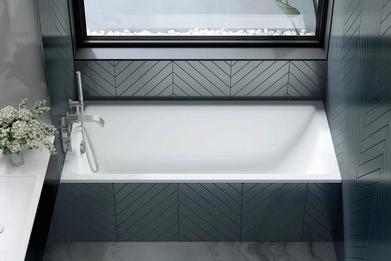
Drop-In vs. Freestanding Bathtubs: Pros & Cons
Drop-In Bathtubs
Pros:
-
Customization and Integration: Drop-in bathtubs are designed to be installed into a deck or platform, allowing for extensive customization. You can select materials and finishes for the surrounding deck to match your bathroom décor, creating a seamless and elegant look.
-
Built-In Storage: The platform surrounding the drop-in tub offers additional storage space for bath essentials like soaps, shampoos, and towels, enhancing bathroom organization.
-
Enhanced Stability: Being fixed into a deck or alcove, drop-in tubs offer superior stability, making them a safer option, especially for households with children or elderly individuals.
-
Easier Installation of Accessories: Drop-in tubs facilitate the integration of additional features such as whirlpool jets, heaters, or custom faucets, providing a spa-like experience right in your home.
Cons:
-
Complex Installation: The installation process for drop-in bathtubs is more complex and labor-intensive, and usually requires a professional contractor.
-
Space Requirements: Drop-in tubs need a built-in deck or enclosure, which can take up more floor space and may not be ideal for smaller bathrooms.
-
Cleaning Challenges: The deck or platform around the tub can create additional surfaces that need cleaning, which might be cumbersome, especially if there are tight corners or gaps.
Freestanding Bathtubs

Pros:
-
Aesthetic Appeal: Freestanding bathtubs are often considered a statement piece, adding a touch of luxury and elegance to any bathroom. Their design can range from vintage clawfoot styles to sleek, modern silhouettes.
-
Flexible Placement: Unlike drop-in tubs, freestanding bathtubs can be placed anywhere in the bathroom, offering greater flexibility in terms of layout and design. This is particularly useful for creating a focal point or maximizing space in unconventional bathroom layouts.
-
Ease of Installation: Installation of a freestanding tub is generally easier and less time-consuming compared to drop-in tubs. It typically involves connecting the plumbing and positioning the tub, often requiring less professional assistance.
-
Space Efficiency: Freestanding tubs do not require a surrounding platform or deck, making them suitable for smaller bathrooms where space is at a premium.
Cons:
-
Stability Concerns: Freestanding bathtubs can be less stable compared to drop-in tubs. They can move or tip if not installed properly, making them potentially less safe for young children or elderly individuals.
-
Limited Storage: With no built-in deck or platform, freestanding tubs lack the convenient storage space for bath products, necessitating additional storage solutions nearby.
-
Cost: While the installation may be simpler, freestanding bathtubs themselves can be more expensive than drop-in tubs, particularly for designer or high-end models.
-
Plumbing Exposure: The plumbing for freestanding tubs is often exposed, which might not appeal to all homeowners. Concealing the plumbing can be an additional expense and design challenge.

